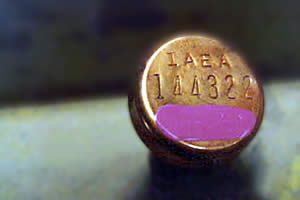Overview
While the International Atomic Energy Agency (IAEA) has safeguarded individual nuclear facilities since 1960, the Agency's current safeguards role was in large part established with conclusion of the Treaty on the Nonproliferation of Nuclear Weapons (the NPT), which obligates parties not possessing nuclear weapons to conclude comprehensive safeguards agreements with the Agency. The model for such agreements is found in IAEA Information Circular 153 (INFCIRC/153). It was under this system that the IAEA was able to establish itself worldwide through the 1970s and 80s.
The Agency took on new political dimensions in the 1990s when it was confronted with verifying activities in potentially noncompliant NPT States: Iraq in 1991 and in North Korea beginning in 1992. Following the first Gulf War, the IAEA was given unrestricted access to Iraqi nuclear facilities for the purpose of determining whether any diversion of materials had occurred or was occurring and to discover, destroy, or render harmless any facilities or equipment that may have been used by Iraq for the development of nuclear weapons. These inspections confirmed that Iraq had an extensive nuclear weapons program underway in violation of its IAEA safeguards agreement and NPT commitments.
By contrast, the initial safeguards declaration made by the Democratic People's Republic of Korea (DPRK), North Korea, presented many questions, including unknown nuclear fuel- cycle facilities and discrepancies in the amounts of separated plutonium.
Despite accomplishments across its spectrum of activities, the events in Iraq and North Korea contributed to the realization that the IAEA was not equipped to detect undeclared nuclear activities, based on existing reporting schemes and inspector access. Programme 93+2 was therefore undertaken by the Agency to develop a strengthened safeguards system that would not only detect diversion of nuclear material from declared facilities, but also assist in the detection of nuclear activities not declared by an NPT party (in violation of its safeguards agreement).

Some of the resulting strengthening measures could be implemented under the existing safeguards system. Other provisions required that a new legal instrument be put in place. This resulted in INFCIRC/540, the Model Additional Protocol, or the AP, which was approved by the IAEA Board of Governors in 1997.
States with an AP in force provide the IAEA a greater body of information on nuclear activities and grant inspector access complementary to that provided under 153-type agreements. The AP significantly enhances the Agency's ability to detect the presence of undeclared nuclear materials or activities. These topics and events, history, and future of international safeguards are the subjects of this video series.
